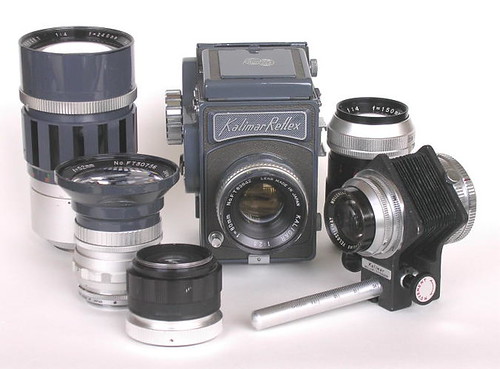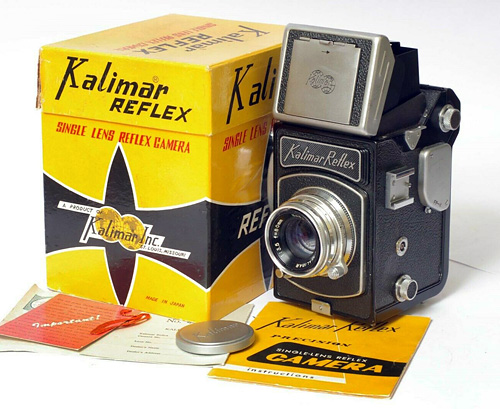Kalimar Reflex

|
| Kalimar Reflex kit image by Rick Oleson (Image rights) |
The Kalimar Reflex is an inexpensive Japanese 6×6 SLR that was a minor improvement on the Fujita 66, adding an instant-return mirror.
Background
When the Kalimar Reflex appeared in 1957 (an upgrade of the short-lived Soligor 66, itself an incarnation of the Fujita 66; all were manufactured by Fujita Optical Company), it was Japan's only (although not first) 6×6 SLR. Worldwide, its competition consisted of the Hasselblad 1000 F (about to be superseded by the new 500 C), the 1954 Exakta 66, but not much else. (The original Bronica was not to appear for another two years, with the Kowa Six, Norita, etc, following in due course.)
Allegedly, the camera was designed by the famous German designer Heinz Kilfitt, who is also credited with the design of the Berning Robot and the Kilfitt Mecaflex.

|
| With original box and literature image by Fred Sherfy (Image rights) |
Lenses
The normal lens was an 80mm f/3.5 triplet of quite adequate performance. Its mount was very awkward to operate, though, and the later Tessar-type f/2.8 offering was a great improvement. Also offered in 1957 was a decent 150/4.0 short tele, an unusual 5-element design in which only the front four moved during focusing; but the big news was the wide angle. At 52mm, this was the widest lens available for a 6×6 SLR anywhere in the world. Adapters were made to fit it to the Hasselblad 1000F, and the combination of 52mm Kaligar and Hasselblad adapter remains a highly desirable item among collectors today.
There was a particular reason why the Kaligar was the widest lens of its day: only about three years after the famous 35mm Angénieux Retrofocus, the 52/3.5 Kaligar was the first retrofocus design lens for medium format. In addition to making wider-angle coverage possible in an SLR, the retrofocus design provided improved corner illumination and made higher apertures possible - and it pointed the way to the future, as this concept would become the basis of the tremendous development in wide-angle lens design over the next two decades.